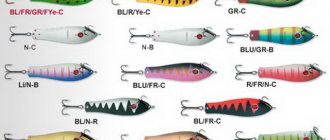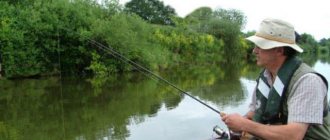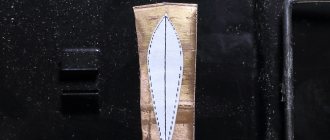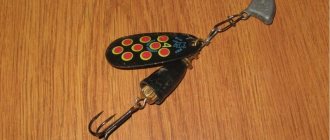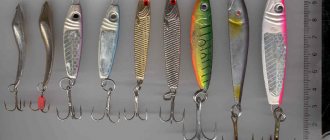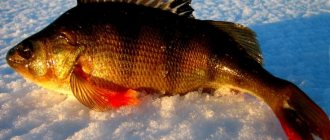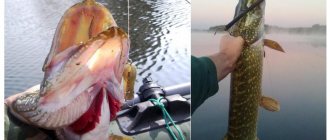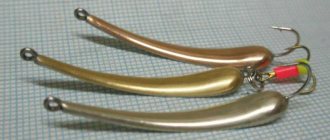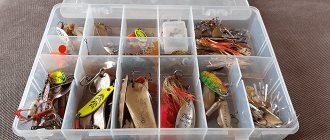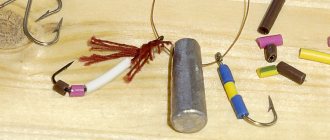What is the Atom spinner
The Atom spinner is an oscillating spinner that has a pear shape. There is a rounded depression in the back of the spoon, and the center of gravity of the bait is located precisely in the rear part. The spoon is equipped with a winding ring at its front end, and at the back there is a treble hook. Atom spinners are made of copper, brass and stainless steel and ferrous metal.
The first models were 70 millimeters long and weighed 14, 18 and 22 grams. The mass of the spoon depended on the thickness of the metal plate from which it was made. Later, the Atom 2 modification appeared, the length of which was 25 millimeters shorter, and the back of the bait was decorated with notches in the form of fish scales.
Currently, Atom spinners are produced by many Russian and foreign companies. They differ from the classic sample in length, thickness, coloring, the presence of additional elements, etc. The Russian Atom should not be confused with the Swedish Abu Garsia Atom spinner, which has a different design.
The Atom spinner is an extremely catchy bait.
Features of the bait game
If we talk about large pike, then on the “Atom” they are caught from the bottom. A slow retrieve is suitable here, which is performed at minimum speed, without moving too far from the bottom. The spoon is cast and sinks to the bottom. Often the blow awaits even while descending to the bottom. When the spoon sinks to the bottom, with sharp and short movements it is thrown to the surface and falls to the bottom again.
After each jerk, the cord is pulled out using a quick turn, after which another 2-3 turns are made, only slow ones. That is, the point is that a couple of revolutions are made, then there is a pause, if a predator is nearby, then it will take it just during the pause. This is a universal method that will work not only on rivers, but also on ponds.
They are also caught using wiring with twitching elements, for which the “Mister Cro Atom” oscillating spoon is ideal. To do this, it is enough to add three to five weak jerks at any moment you like. During this, the spinning rod must be in a horizontal position. At this moment, the spinner's play will resemble the movements of a wobbler, that is, it will move from side to side.
Sometimes monotonous jerking wiring is done. This is when the rod jerks two or three times, then pauses and jerks again. This attracts a predator. There is also a similar technique, but each jerk should be harder, have a constant amplitude and a vertical position of the spinning rod.
Then the bait will move to the sides and approach the surface. It would be a good idea to count the seconds before the vibrator falls to the bottom, so the picture of the bottom will be clear, including pits and edges. The spinner cord must always be taut; this is the only way to hook a predator in time.
If these methods do not give results, then a smooth, monotonous wiring with rare, short pauses will do. This can be either surface wiring, or approximately in the middle water column. Perch and pike actively take it, although everything depends on the reservoir, weather, time of year, type of spoon, etc.
Options
Among the characteristics, the most important are the following.
Size
As already mentioned, the original Atoms were 7 centimeters long . This size can be considered optimal for catching pike, pike perch and salmon in most cases. However, quite often situations arise when a predator prefers small baits. In order to successfully catch predators in various conditions, the Atom line of spinners has been expanded. Now you can find Atoms of various sizes, the smallest are 25 millimeters long and are intended, among other things, for catching perch.
Weight
The mass of the Atom spinner, in addition to its length, is determined by the thickness of the metal from which it is made. Spoons of the same length but different weights are used for fishing at different depths and for retrieving at different speeds.
Color
Most Atom spinners are not painted, i.e. have the color of the metal from which they are made. New lures always shine, but over time they fade, and you can restore their shine with the help of special pastes. However, bright shine is not always good, and many anglers use dull spoons, smoking them over a fire. Painted lures are also popular, especially among salmon hunters.
Form
All Atom spinners are pear-shaped and have a recess in the back, but their geometry can change when the proportions change, i.e. ratio of length and width.
What kind of fishing is it suitable for?
The Atom 2 bait is suitable for catching predatory fish in still or low-flow water. You can catch the following types of fish with it:
- Pike. Pike is the main catch when fishing on Atom.
Depending on the mass of the bait, the fishing depth is 1.5-4 meters. Fishing with an Atom involves the use of two main types of retrieve: uniform and jerky, but not as intense as when fishing with wobblers by twitching, but more similar to a stepped one. But the same uniform retrieve does not mean that the angler must turn the reel handle at a constant speed - you can make small accelerations and decelerations of the retrieve, while playing along with the tip of the spinning rod. In jerking, the moment of pause is important when the spoon, waddling, falls to the bottom. - Zander. With the advent of jig baits, wobblers, VIBs, etc. The relevance of spoons for catching fanged predators has decreased somewhat. However, pike perch can be successfully caught on the Atom by casting, using uniform and stepped retrieves, as well as trolling.
- Perch.
For perch fishing, the Atom 2 spinner is not a priority bait. These spoons are used when the task is to catch a trophy fish, but the size of the bait should still be small.
- Asp. Good range is an advantage of the Atom when hunting for a “river torpedo”, but its ability to fall into a tailspin in the current is a disadvantage of the spoon. Therefore, the Atom should be used for precise throws in the hope that the predator will react to the bait immediately after it splashes down.
- Som. To catch catfish, heavy bait models are used, which should be slowly carried out in the bottom layer at a relatively constant speed.
- Salmon. Since the Atom cannot fully reveal its qualities in a strong current, it recommends using it when casting into pockets behind stones or into the “return”, as well as when trolling at low speed.
Secrets of catching pike with Atom spinners
If the hunt is for perch or pike, the fisherman must pay attention to the places where the fight takes place. This is the time when, within a certain radius, small fish jump out of the water, scared away by large predatory fish. Moreover, several fish can jump out at the same time. This is a sure sign that a predator is in charge of this place.
To begin with, it is better to make several runs using the described methods at the bottom, since production, as a rule, is there. If there is nothing, it may be a perch or small pike, so you should make several surface or half-depth retrieves. In still water, the “Mister Cro Atom” spinner is suitable, so the game of the tackle will be more realistic.
How to make it yourself
To make an Atom spinner with your own hands, you will need the following materials:
- sheet metal 1-2 millimeters thick;
- winding ring or ring with swivel;
- winding ring with treble hook.
Expert opinion
Knipovich Nikolai Mikhailovich
Zoologist, hydrobiologist. I am interested in fishing at a professional level.
Important! The tee should not be too small. In size it should correspond to the width of the spoon or slightly exceed it.
Tools:
- metal scissors;
- drill;
- punch;
- hammer;
- file;
- grinding materials.
Drawing and production
Before you begin, you should make a drawing of the future bait, which should show all the proportions of the product.
The manufacturing process looks like this:
- First, a template is made from thick cardboard.
- Trace the contours of the spinner on the metal according to the template.
- Cut out the workpiece.
- Using a punch, a recess is formed in the back of the workpiece.
- Drill holes for the winding rings in the front and rear parts of the workpiece.
- The spinner is processed.
- Carry out assembly.
Spinner manufacturing process
1 - On a piece of tin, draw (or draw with an awl) the contours of the petal of the spoon according to the supplied dimensions. Cut it out. We process it with a file. The petal template is ready.
2 - Apply the template to the metal for the petal - outline it. Carefully cut out. Straighten, if necessary, with a hammer.
3 - We pierce a hole in the petal and drill it out (countersink) with a screwdriver.
4 - Use a file to remove the burrs, and use pliers to bend the “wings” at the back of the petal. It is enough to bend it 5–10°. The petal of the spinner is ready.
We make a simple head from lead - a triangle, or use a ready-made head weight. We put a petal with a collar on the wire axis, two beads - a smaller and a larger one, a piece of a spring or a hard plastic tube - we make a clasp, attach a hook... Our homemade lure is all ready.
While I was making the spinner, I came up with an even simpler spinner, “Stripe”. The only difference is that the edge of the petal bends at an angle of 30–45°.
All that remained was to check the performance of our homemade spinners, which was done. On my first fishing trip I caught a kilogram pike on the “Delta”, and a perch on the “Strip”. The funny thing is that the pike was caught in a place where, it would seem, he had caught everything tightly with wobblers. And I only caught a small perch. So our fish can be easily caught using homemade spoons from the 80s, and they often turn out to be more effective than proven modern baits.
Both spinners start well, allow for very slow retrieving, and thanks to the clasp, they can easily be equipped with a twister on an offset hook. You can experiment with coloring the petal of the spoon with waterproof markers or sticking reflective film. At minimal cost, we got spinners that are not scary to use in snags, and most importantly, that catch fish.
Dmitry Shokh
fisherman2000.mirtesen.ru
How to improve or upgrade
One of the widespread methods of tuning the Atom, as well as other oscillators, is to attach a red plastic plate shaped like a fish tail to the rear winding ring. Many fishermen believe that the use of this part as an element that increases the catchability of the spoon is very doubtful.
On spoons made of copper and brass, you can apply a pattern imitating fish scales using vulcanite.
Ferrous metal spinners can be silver plated or coated with copper using electrolysis.
Expert opinion
Knipovich Nikolai Mikhailovich
Zoologist, hydrobiologist. I am interested in fishing at a professional level.
Healthy! A great idea is to make an Atom-unhooked spinner for catching pike in “toad fisheries”. To do this, an offset hook is soldered into the back of the spoon, pre-bent so that its bend coincides with the profile of the spoon. Protection against snags is provided by a loop made from a guitar string, which is soldered to the front of the spinner from the inside or glued with polyester.
Tactics and fishing techniques
Fishing tactics and techniques depend on what kind of fish the angler is going to catch.
Zander
First, you should determine the locations of promising pike perch sites. Any snags and shell rock are excluded due to snags. You should look for pike perch on coastal dumps, edges, exits from holes and entrances to them, i.e. where they usually fish with a jig spinning rod. Convenient places for fishing are places with weak or no current. The spoon should be driven along the bottom, following changes in the relief.
Perch
For perch, small spoons are used. You can fish using the same tactics as when fishing for pike perch, but fishing in “cauldrons” that are formed when a schooling perch drives the fry to the surface is more interesting and productive. Sometimes the perch does not allow you to get close to the battlefield, and then the Atom 2 can turn out to be a much more catchy bait than a wobbler flying nearby. When fishing in “cauldrons”, a bite can follow immediately after the bait splashes down. If this does not happen, then the retrieval should be as fast as possible - just so that the spoon does not fall into a tailspin.
Pike
Pike are caught on the Atom either by identifying a promising location visually or by knowing the bottom topography. When fishing for pike, any type of fishing is used, adapting to the mood of the predator.
